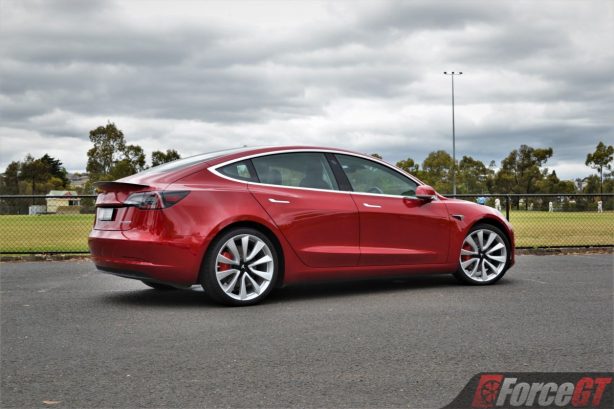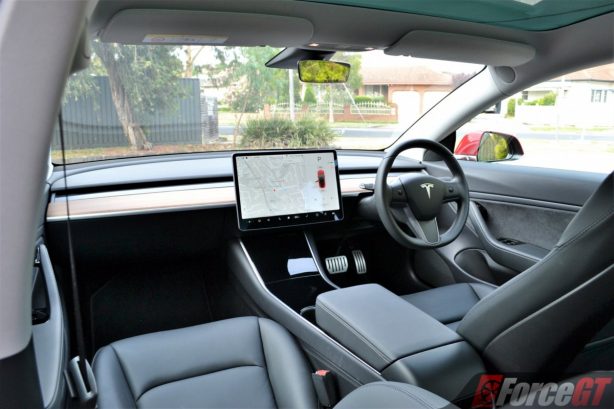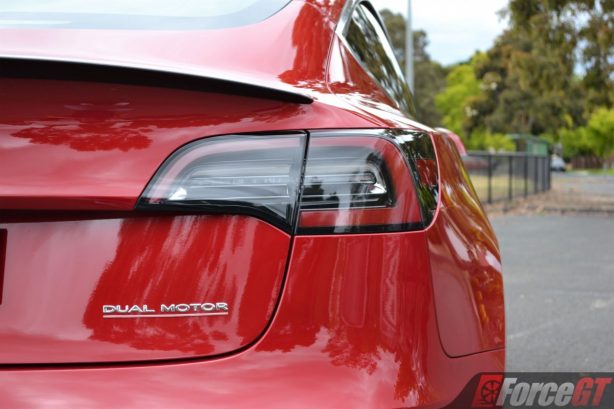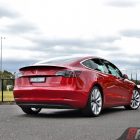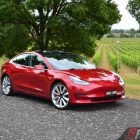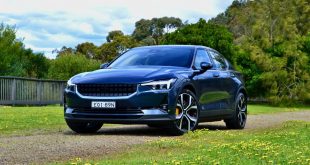The Model 3 is Tesla’s electrical vehicle for the masses. Priced from ‘just’ $66,000 plus on-road costs it is the least expensive Tesla currently on sale in Australia and plays in the one of the most important and largest premium passenger car segments, the compact luxury sedan. This means the Model 3 is up against established nameplates such as the BMW 3 Series, Mercedes-Benz C-Class and Audi A4. The Model 3’s draw card is of course its full electric drivetrain which none of its competitors have, not yet at least.
So, does the Californian car have enough to sway buyers away from the more heritaged, combustion-engined European rivals? We sought to answer that after spending a weekend with the range-topping variant of the Model 3, the Model 3 Performance.
First thing first, Tesla claims that the Model 3 Performance is in the same realm as the BMW M3 as far as driving dynamics and performance is concerned. With a base price of $93,900 plus ORCs, a whole $30k cheaper than the M3, that seems like a bargain. For that price you get a dual motor all-wheel drive set up, performance brakes, carbon fibre rear spoiler, performance pedals, 20-inch wheels, all black interior including black headlining, and the Autopilot semi-autonomous driving feature. Our tester also came coated in a striking red multi-coat paint which is the only option added priced at $2,900. All in, our Model 3 Performance checks in at a total of $98,175 including $1,375 in delivery fee but excluding on-road costs.
Expensive but still relatively sensible considering the tech and performance on offer. But before we dive into that let’s talk about the way it looks. If you think the Model 3 resembles a shrunk Model S, you’re absolutely right. Given how sleek the S is, the 3 is inherently a pretty thing to look at, with a swooping roof line, low nose and high rear deck. Its clean, uncluttered design is unmistakably Tesla and its footprint is just perfect for the city – not too large, not too small. The only oddity we find with the styling is the rather tall glass house which when viewed head on from the front looks a little out of proportion. Other than this, the 3 is one classy, premium and contemporary luxury sedan.
Oh, but this is the flagship Performance variant and here’s wishing there was more differentiation between this and the bread and butter models. Perhaps the addition of a front lip spoiler and a larger rear diffuser? It is, according to Tesla, an M3 rival anyway.
The Model 3’s cabin is a progression from the Model S’ maxi-minimalist interior, only that the 3 is even more minimalist. The dashboard is absolutely bare bone except for a slab of wood trim that runs the width of the dash and a giant landscape orientated 15-inch touchscreen perched right in the middle. Where are the air-con vents? No, it doesn’t yet have the SpaceX Starship’s oxygen generator, but the vents are cleverly integrated into the dash, running the full width slotted in between the wood trim and the upper dash. Adjusting air flow requires a mere finger movement on the touchscreen. Cool stuff.
Speaking of the touchscreen, it’s an ultra high clarity and resolution iPad-like screen that serves as the interface for almost every function. From climate control and satellite navigation to light switches and boot release, it’s all done via the infotainment touchscreen. The only buttons you’ll find in the cabin are those for the powered windows, hazard lights, and door release ( yup, you press a button on the door grab to open each door, though a physical lever is there in case the button stops working). Even the steering wheel is devoid of any buttons except for two unmarked scroll wheels (deliberately left blank so Tesla can change their functions anytime via software updates).
While streaming your favourite tunes on Spotify and TuneIn radio is nothing new in a Tesla, the latest version 10.0 infotainment software now even allows you to stream movies and shows on Netflix and YouTube (when the car is parked, of course). There’s also a new “Car-aoke” feature that lets you sing your heart out with friends on a road trip – or by yourself. Caraoke comes with a massive library of music and song lyrics, with support for multiple languages.
But our favourite new feature is none other than Tesla Arcade which offers a variety of in-built games from run-and-gun action to car racing, the latter allows the use of the car’s actual steering wheel for steering.
You’ll also find the lack of an instrument cluster and that’s because it, too, has been integrated into the centre screen. It’s suitably positioned on the top right of the screen (for right-hand-drive models) but nothing beats a proper instrument cluster behind the steering directly in front of you. If Tesla was worried about over-cluttering, then perhaps a head-up display would be nice. This, sadly, is not even available as an option.
Fortunately, there’re multiple charging points for your phone (though a wireless charging pad is still sorely missing), and unlike the Model S the 3’s door cards feature deep storage pockets and bottle holders. Because the gear lever is a stalk on the steering, the centre console is freed up for storage and here you’ll find deep-lidded compartment and more cup holders.
Passenger space is abundance, easily one of the most spacious in class with acres of headroom for anyone up to six-foot tall thanks to the high roof. The seats are comfortable but could do with more shoulder support, considering this is a sports variant. But the best bit about being a passenger in the Model 3 is that endless view out through the full-length sunroof that wraps around and behind your head with no connecting beams. Fabulous.
Because there’s no engine, the Model 3 has two boots. There’s the conventional boot in the back, which is deep and square but with an aperture that is a little small, and a smaller second boot in front where an engine would normally sit in a non-EV sedan. In total you get 425 litres of cargo capacity, 55 litres shy of the single boot BMW 3 Series.
In terms of build quality, the Model 3 is miles better than what we have seen from Tesla previously, but still a small step behind established European and Japanese premium players. The gap between the frameless window and the door for instance can be tighter. This is letting in some wind noise into an otherwise whisper quiet cabin. The interior materials are, however, appropriately plush for this price point.
Alright, enough of the nitty-gritty. How does it drive? This is a Tesla so it must have that stupendous acceleration that Tesla is renown for. Yup, the Model 3 Performance does the 0-100km/h sprint in a supercar-beating 3.4 seconds. On paper, yes, but we tried it out and it stopped the clock at 3.6 seconds. That is still savagely quick!
It’s all thanks to the dual electric motors – one at each axle – affording all-wheel drive, plus the high capacity battery pack. It develops a combined output of 335kW and a staggering 638Nm of torque. With batteries stuffed in the floor pan of the car for the lowest centre of gravity, the car weights in at 1856kg, hefty but there’s still the power to weight ratio of 180.5 kW/t.
Coupled that with instant torque from the electric motors, every squeeze of the right pedal is a shove in the back. And you’ll find every opportunity to stomp on the throttle and see the outside world reels in at warp speed. It’s addictive yet strange at the same time because no matter how you drive this thing it’s always silent. There’s just that slight whine from the motors and the aforementioned wind noise, other than that it’s eerily quiet and amazingly refined.
EVs aren’t well known for their handling and Tesla’s in the past have been a bit of a mix bag in this department, but not the Model 3 Performance. This thing corners like it’s on rails. There seems to be endless amount of grip from its all-wheel drive system and the lack of body roll isn’t what you’d expect from a rather high-riding four-door sedan.
The steering is the quickest and sharpest of all Tesla’s we have driven, though almost completely devoid of feedback – a common trait of EVs, the brakes are powerful with a pedal feel that is nicely progressive, and the chassis feels wonderfully neutral with the nose tucking into corners eagerly at your input. It all adds up to a very secured, very alert and blisteringly quick drive.
But it’s no M3, certainly not in engagement and theatrics, though that’s to be expected with the Model 3 being a full electric car.
The firm suspension set up – single tune and non air sprung – allows just enough of road feedback through the chassis while staying compliant and smooth over all but the roughest of surfaces. It rides like how a compact family sedan should, with just a tinge of sportiness to remind you that this is no ordinary Model 3. It’s exactly how we like our sports sedan to ride.
Every Model S is equipped with Autopilot – one of the most advanced semi-autonomous driving systems on the planet. Autopilot allows the car to steer, manage speed and brake all on its own. While you still need to have your hands on the wheel at all times, the system does take away the stress and fatigue of long distance driving, allowing you to just sit back and relax through that 8 hour interstate trip.
On a side note, every Tesla coming out of the factory now has the necessary hardware for full self-driving capability. Once Tesla has cleared all the hurdles – legal issues and insurance matters – we’ll be seeing the world’s first self-driving production car. And you’d better believe it’s not too far away.
The Model 3 Performance offers a ‘guilt-free’ range of up to 560km, depending on how you drive. On test we managed to clock 430km before needing to charge, that range admittedly includes some heavy right-footed driving and air-con on for half the time.
Charging the car is as easy as charging your mobile phone. One end of the charge lead connects to the car and the other end plugs into any common power socket in your home. A full charge through a domestic 10A outlet will take north of 8 hours. But take it to a Tesla Supercharger charge point and a full replenish will take just a little under an hour.
For most people the $66,000 entry level Model 3 Standard Range Plus is good enough. In fact, it’s all you ever need in an electric car that gets you to and from work plus the occasional weekend trip out of the city. With a range of about 402km from a single charge, the base Model 3 does the century sprint in 5.6 seconds – not as insane as the Performance but still quick.
Tesla’s ever expanding charging network in Australia means charging your Model 3 is only going to be easier over time. There are charging stations already in city centre car parks, major shopping malls and tourist hot spots in the country. And if you live in the eastern states, Tesla claims the next Supercharger station is always within reach before you run out of juice. Yes, you can now drive from Adelaide to Melbourne, and on to Sydney and finish off in Brisbane in pure electric power.
But the best way to charge the Tesla is from a wall connector at home. And if you install a Tesla Powerwall battery storage integrated with rooftop solar panels, you will be running your Tesla on the best renewable energy known to us – the Sun.
Verdict
Design & Comfort
Performance & Handling
Quality
Economy
Equipment & Features
OUR SCORE
4.3/5
+ Plus
- Clean, elegant design
- Space-age interior
- Quietness and refinement
- Supercar acceleration, remarkable handling
– Minus
- Vague steering
- No wireless phone charger
- Refueling is still quicker than charging
Overall
The Model 3 is the culmination of the best from Tesla and it has been a long time in the making. Technology and fine tuning developed for the Model S and Model X, the company’s two full volume models that came before the Model 3, have been further refined and adapted in the latter. This coupled with all the lessons learnt, both in manufacturing technique and quality management, have helped create the best Tesla ever. It’s fast, it rides well and it’s brimmed full of tech. But most importantly it’s a genuinely affordable mass-market EV.
2020 Tesla Model 3 Performance Pricing and Specification
| Price: | From: $93,900 (Model 3 Performance) excluding on-road costs As tested: $98,175 driveaway Options included: Red multi-coat paint – $2,900 |
| Warranty | 4 years / 80000 km |
| Warranty Customer Assistance | 4 years roadside assist |
| Country of Origin | United States of America |
| Powertrain | Electric motors (dual) total output: 335kW, 638Nm |
| Drivetrain | All-wheel drive |
| Power to Weight Ratio (W/kg) | 180.5 |
| 0-100km/h (seconds): | Claimed: 3.4; Tested: 3.6 |
| Efficiency: | Claimed: 18 kWh/100 km; Tested: 21 kWh/100km WLTP Range: 560km; Tested: 430km |
| Body | 4-door sedan, 5-seats |
| Safety | 5-star ANCAP, 7 airbags, ABS, EBD, BA, VSC, Automatic Emergency Braking (AEB), blind spot monitoring system, lane keeping assist, speed limit sign recognition, reversing camera with 360-degree view |
| Dimensions (L/W/H/W-B) mm | 4,694/1,933/1,443/2,875 |
| Kerb Weight (kg) | 1,856 |
| Entertainment | 15-inch touchstreen infotainment system, satellite navigation, Bluetooth, USB, AM/FM/DAB, 15-speaker stereo, Netflix, YouTube, Spotify, TuneIn |
Competitors:
Hyundai Ioniq, Nissan Leaf, Polestar 2, Kia EV6
 ForceGT.com Car News, Car Reviews, Video Reviews, Tuning and much more.
ForceGT.com Car News, Car Reviews, Video Reviews, Tuning and much more. 
